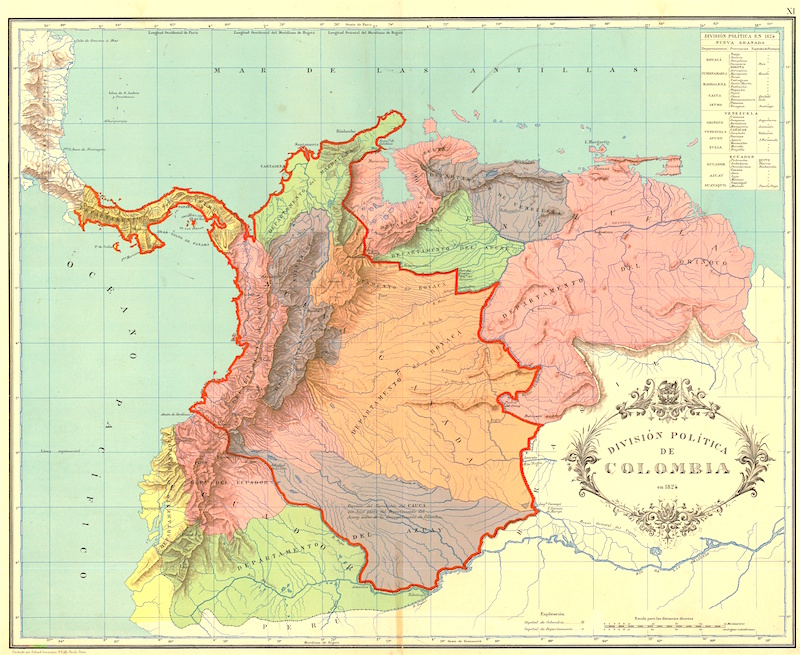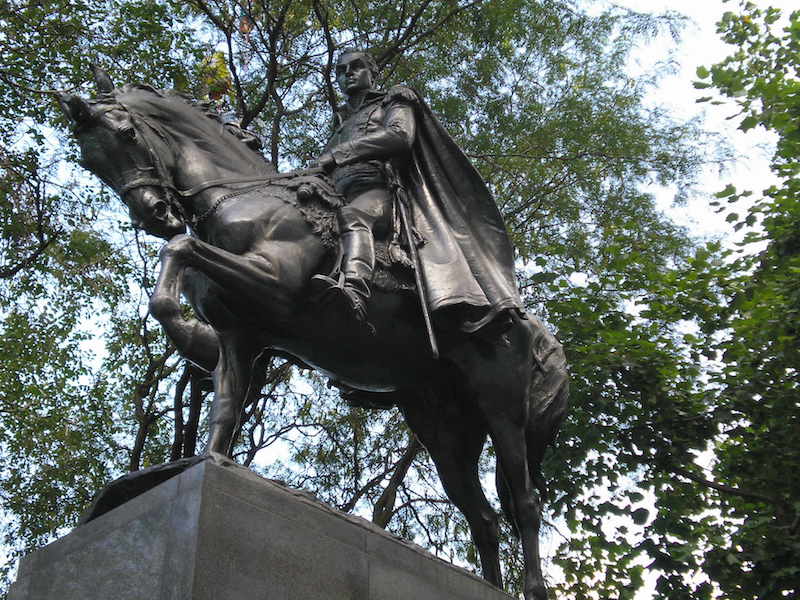
Sally James Farnham, Equestrian Portrait of Simón Bolivar, dedicated 1921, bronze, 13 feet 6 inches tall (located at Central Park South and Avenue of the Americas, New York City) photo: David Shankbone, CC BY 2.5
The roots of Independence
The extensive Spanish colonies in North, Central and South America (which included half of South America, present-day Mexico, Florida, islands in the Caribbean and the southwestern United States) declared independence from Spanish rule in the early nineteenth century and by the turn of the twentieth century, the hundreds of years of the Spanish colonial era had come to a close. How did this happen? The Enlightenment ideals of democracy—equality under the law, separation of church and state, individual liberty—encouraged colonial independence movements in the late nineteenth and early twentieth century. The Enlightenment began in eighteenth-century Europe as a philosophical movement that took science, reason, and inquiry as its guiding principles in order to challenge traditions and reform society. The results of these changes in thought are reflected in both the American and French revolutions—where a monarchical form of government (where the King ruled by divine right) was replaced with a Republic empowered by the people.
In Spain, the occupation by Napoleon during the Peninsular War (1808-1814) also inspired liberators to fight against foreign invaders. The examples of rebellion in the British Colonies, France, and Spain empowered Latin American revolutionaries who speculated on whether independence was a realistic and viable alternative to colonial rule. The term “Latin America” originated in the nineteenth century, when Argentinean jurist Carlos Calvo and French engineer Michel Chevalier, in reference to the Napoleonic invasion of Mexico in 1862, used the term “Latin,” referring to those whose national language—like Spanish—was derived from Latin, to denote difference from the “Anglo-Saxon” English-speaking people of North America.
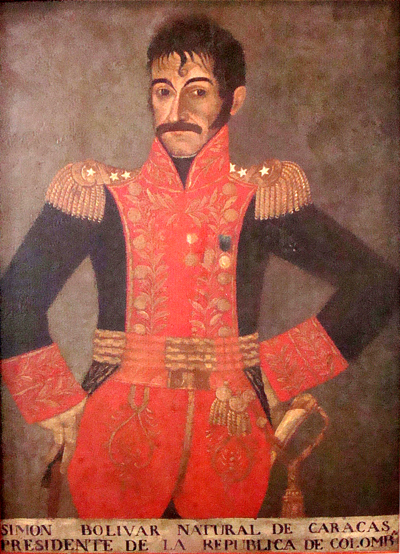
Pedro José Figueroa, Simón Bolívar: Liberator of Colombia, c. 1820, oil on canvas, 95 x 64 cm (Museo Nacional de Colombia, Bogotá)
It was largely the creoles who instigated the fight for liberation. Creoles remained connected to Europe through their ancestry and since they were often educated abroad, these ideas of self-determination held great appeal for them. Peninsulares on the other hand were more directly tied to Spain in ancestry and allegiance. In 1793, the Colombian creole Antonio Nariño, who would later serve as military general in Colombia’s struggle for independence, printed a translation of the French Declaration of the Rights of Man and of the Citizen, demonstrating the bilingual and bicultural aspect of Latin American independence. Translations of speeches made by the founding fathers of the United States, including Thomas Jefferson and John Adams, also circulated in Latin America.
Not all creoles however, believed in independence and democracy—in fact, there existed an opposition of creole royalists who supported the Spanish Crown and allied themselves with the Peninsulares. Creole patriots (as opposed to the royalists) were attracted to the idea of independence and thought of themselves as Latin Americans, not as Spaniards. Despite having been born and raised in a Spanish viceroyalty to Spanish parents, they were culturally connected to Latin America. Situated at the interface of both identities, creole patriots considered themselves descendants of, but different from, the Spanish.
Simón Bolívar
In 1819, Simón Bolívar (above) articulated a concept of a Latin American identity that was racially unique, stating that “our people are nothing like Europeans or North Americans; indeed, we are more a mixture of Africa and America than we are children of Europe….It is impossible to say with any certainty to which human race we belong.”1 With this newfound sense of Latin American identity, creole revolutionaries approached independence from the standpoint of the Enlightenment, but with an added cultural dimension informed by their local experiences.

Général Toussaint Louverture (Kurt Fisher Haitian History Collection, New York Public Library)
The first two, and most notable, countries in the Americas to gain independence were the United States (1776), led by General George Washington, and Haiti (1804), led by Toussaint L’Ouverture (left). Other Latin American countries, with the exception of Cuba and Puerto Rico, also embarked on their struggles for independence in the early nineteenth century—Chile and Mexico, for example, began in 1810, though their autonomy was not secured until later: Chile in 1818 and Mexico in 1821. Since territories were freed in sections with the ultimate goal of liberating an entire viceroyalty, the fight for independence came slowly and in stages.
In the northern part of South America, Simón Bolívar initiated his fight for independence by liberating the countries that formed part of the Viceroyalty of New Granada. On August 30, 1821, Gran Colombia, a conglomerate of recently freed countries formerly part of the Viceroyalty of New Granada (including modern-day Colombia and Venezuela), was established at the Congress of Cúcuta (see map below). At this same congress, Bolívar was elected president.
Following the liberation of Ecuador in 1822, and of Panama in 1821, Gran Colombia grew with the inclusion of both these countries. In his attempts to liberate as much of Latin America as possible, Bolívar traveled further south and freed Bolivia in 1825—a country whose name pays homage to its liberator.
Heroes, Martyrs, and Liberators
Despite economic volatility and political upheaval, there was a desire among nationals for artists to document Latin America’s autonomy and in the process create a new Latin American iconography. Portraits of liberators, allegorical depictions of independence, and representations of important battles comprised the artistic production of the early nineteenth century. Tied to the desire to establish a national identity, portraiture and history painting were in high demand—the former documented the likenesses of revolutionary figures, while the latter recorded the major battles and landmark events of independence. While these genres existed before independence, their popularity significantly increased in the early nineteenth century.
With the exception of Mexico, Cuba, and Brazil, there existed no government-sponsored art school or established artistic communities in early post-independence Latin America. As a result, artists were either trained within small art studios, or by working artists, or in many cases were not formally trained at all—which helps to explain the diversity of styles in early nineteenth century painting. Often neglected or even wrongfully categorized, the early nineteenth century is a time of transformation when both artists and viewers were adapting to a changing society, articulating a sense of national identity, and in the process, creating a new artistic tradition.
Portraits
El Libertador Simón Bolívar was born in 1783 in Caracas, Venezuela to an aristocratic family. He was tutored by Simón Rodríguez, who introduced Bolívar to the work of Enlightenment philosopher Jean-Jacques Rousseau—specifically his ideas on the origins of inequality. Bolívar’s privileged background also permitted him to travel abroad, and in 1804 he met the French Emperor Napoleon Bonaparte and the Prussian naturalist, and explorer, Alexander von Humboldt who had travelled extensively in Latin America and ignited Bolívar’s patriotism.
Bolívar posed for Colombian painter Pedro José Figueroa, a descendant of a colonial family of portraitists and miniature artists. In Simón Bolívar: The Liberator of Colombia (above), Figueroa emphasizes Bolívar’s military triumph through the three medals that decorate his uniform: the Order of the Liberators of Venezuela, the Cross of Boyacá and the Liberators of Cundinamarca. In another portrait by Figueroa (below), The Liberator is depicted in military uniform with large gold epaulettes, a sword dangling from the waist, and a prominent belt with his initials “S.B.” imprinted on the buckle.
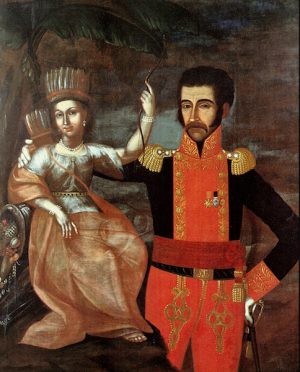
Pedro José Figueroa, Bolívar and the Allegory of America, 1819, oil on canvas, Museo Quinta de Bolivar, Bogotá (Ministerio de Cultura de Colombia)
In both portraits by Figueroa, Bolívar appears almost entirely frontal, his posture stiff and anatomy awkward—a colonial aesthetic that the artist carries over into the nineteenth century. Privileging textures, color, and clothing, these paintings stress the historical or social importance of the sitter. The use of text within a portrait—another hallmark of colonial painting—appears in the two Figueroa portraits of Bolívar, as well as in Portrait of Bolívar in Bogotá by José Gil de Castro (below). In each of these portraits, the use of text helps to reinforce Bolívar’s heroism, stating yet again, and this time in written form, that he is indeed El Libertador. While military dress seems to be a consistent feature in the portraiture of Bolívar, his facial features and skin tone change according to artist. Despite the fact that Bolívar was a creole, Figueroa calls attention to his uniquely Latin American character by depicting him with darker skin—a reference to the racial mixing that characterized Latin America after colonization.
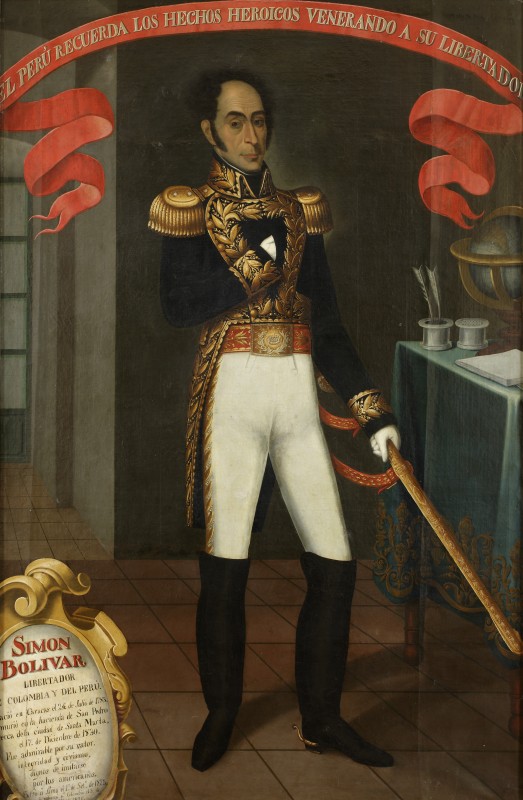
José Gil de Castro, Portrait of Bolívar in Bogotá, 1830 (Museo Nacional de Arqueologia, Antropoligia, e Historia del Perú, Ministerio de Cultura del Perú)
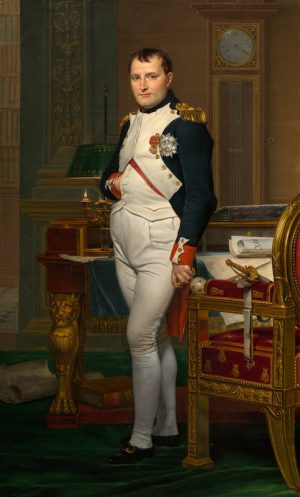
Jacques-Louis David, Napoleon in His Study at the Tuileries, 1812, oil on canvas, 203.9 x 125.1 cm (National Gallery of Art)
In contrast to Figueroa, Gil de Castro presents Bolívar in a full-length portrait, providing a view of both The Liberator and his surroundings. The format and composition of the portrait, as well as the pose, recall The Emperor Napoleon in His Study at the Tuileries by the French artist Jacques-Louis David (left). The interior view of both portraits provide further information about the personalities of these generals. In the case of Napoleon, for example, David includes a copy of Plutarch’s Lives on the floor, in an attempt to position Napoleon within an ancient lineage. In Gil de Castro’s portrait of Bolívar, the globe placed prominently in the background announces Bolívar’s worldliness and regional ambitions, as reflected in his liberation of multiple Latin American countries.
The military attire and heroic pose of Bolívar, shown with one hand tucked inside his jacket and his body positioned at an angle, recall the portrait of Napoleon. Though both portraits represent interiors—far from any battle—Bolívar and Napoleon proudly wear their military uniforms. The military heroism of Bolívar is further accentuated by the red banner of text at the top, which reads “Peru recalls the heroic deeds revered to its Liberator.” Painted in 1830, the year of Bolívar’s death, Gil de Castro depicts an aging yet noble Bolívar, quite different from the young liberator seen in Figueroa’s earlier portrait (top of page). The strong similarities between Portrait of Bolívar in Bogotá and The Emperor Napoleon in His Study at the Tuileries, as well as with other full-length portraits of military generals, suggest that even after independence Latin American artists continued to look to Europe for artistic models.
History Painting
While portraiture could capture the personality and physical features of a hero, its potential to convey narrative was limited. History painting solved this problem, allowing artists to record the pivotal battles or moments in the wars of independence. Additionally, and perhaps more importantly, history painting was often imbued with moral lessons about heroism and patriotism. As a result, in European art it was considered the most elevated genre of painting—above still life, landscape, and portraiture.
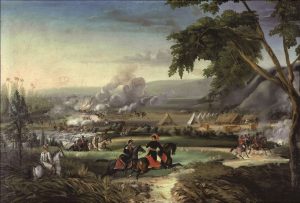
José María Espinosa, Battle of Palo River, c. 1850, oil on canvas, 81 x 121 cm (Museo Nacional de Colombia, Bogotá)
Historical subjects were also painted by some of the same artists who created portraits of the heroes of Latin American independence. This was the case with the Colombian creole painter José María Espinosa, a largely self-taught artist who specialized in miniature portraits, but who had also served in General Nariño’s Campaign of the South. Painted from memory but based on first-hand experience, Espinosa memorialized the battle of Palo River. Probably due to his lack of experience with this new genre, Espinosa organized his composition as if it were a landscape. Focusing on the topography and vegetation of Colombia rather than on particular military heroes and pivotal moments, Espinosa’s Battle of Palo River (above) is better understood as a landscape view rather than a representation of the particulars of an historical event. His landscapist approach is also reflected in his handling of the composition, in which he delineates foreground, middle ground, and background, creating an illusionistic sense of deep space. In the foreground, the ground closest to the viewer, two military soldiers energetically ride on horseback, while in the middle ground the battle intensifies near the river, all culminating in a peaceful sunset. The cropped tree positioned at right frames the event, which unfolds in various stages culminating in the background.
The end of Gran Colombia
Despite the ambition of Gran Colombia, it remained politically complex, and worsened when Bolívar proclaimed himself dictator in 1828, a move he justified by pointing to insurrections. He became increasingly unpopular and that same year survived an assassination attempt. After 1828, Bolívar retreated to Santa Marta, Colombia where he died in 1830 while awaiting voluntary exile in Europe. Despite his attempts to create unity, and with the wars of independence now over, Latin American countries no longer saw a reason for partnership. Gran Colombia dissolved in 1830, and in the ensuing decades the countries of Colombia, Venezuela, Ecuador and Panama, as we know them today, were established.
1As quoted in Marie Arana, Bolivar: American Liberator (Simon and Schuster, 2013), p. 223.
Additional resources:
Vistas: Visual Culture in Spanish America, 1520-1620 (Fordham University)
Art of the Spanish Americas on The Metropolitan Museum of Art’s Heilbrunn Timeline of Art History

